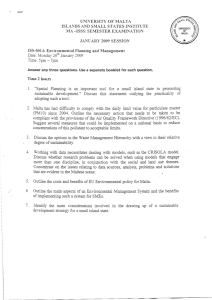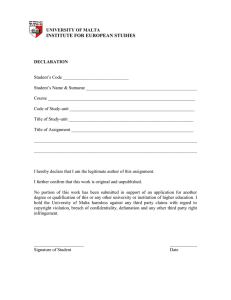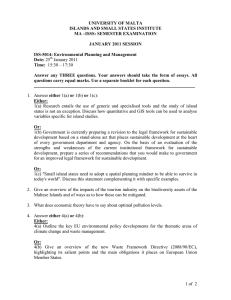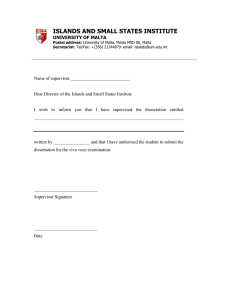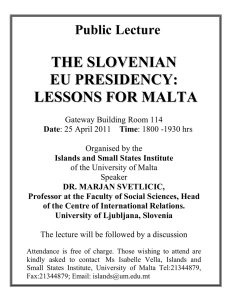Global Environmental Change and Small Island States and Territories:
advertisement
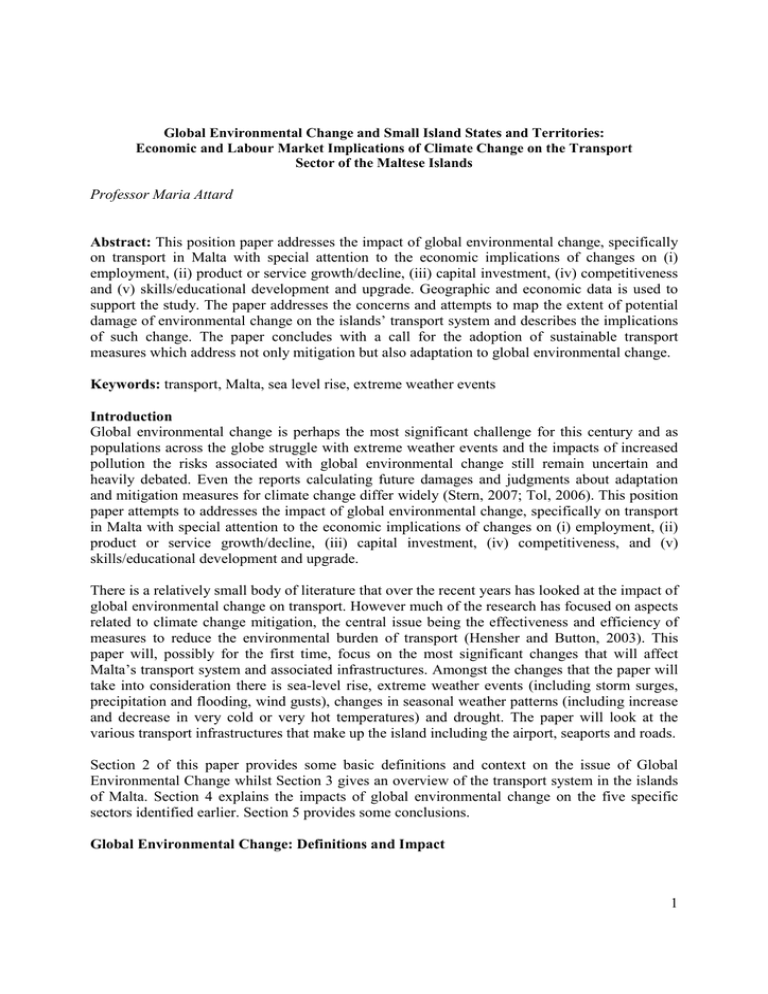
Global Environmental Change and Small Island States and Territories: Economic and Labour Market Implications of Climate Change on the Transport Sector of the Maltese Islands Professor Maria Attard Abstract: This position paper addresses the impact of global environmental change, specifically on transport in Malta with special attention to the economic implications of changes on (i) employment, (ii) product or service growth/decline, (iii) capital investment, (iv) competitiveness and (v) skills/educational development and upgrade. Geographic and economic data is used to support the study. The paper addresses the concerns and attempts to map the extent of potential damage of environmental change on the islands’ transport system and describes the implications of such change. The paper concludes with a call for the adoption of sustainable transport measures which address not only mitigation but also adaptation to global environmental change. Keywords: transport, Malta, sea level rise, extreme weather events Introduction Global environmental change is perhaps the most significant challenge for this century and as populations across the globe struggle with extreme weather events and the impacts of increased pollution the risks associated with global environmental change still remain uncertain and heavily debated. Even the reports calculating future damages and judgments about adaptation and mitigation measures for climate change differ widely (Stern, 2007; Tol, 2006). This position paper attempts to addresses the impact of global environmental change, specifically on transport in Malta with special attention to the economic implications of changes on (i) employment, (ii) product or service growth/decline, (iii) capital investment, (iv) competitiveness, and (v) skills/educational development and upgrade. There is a relatively small body of literature that over the recent years has looked at the impact of global environmental change on transport. However much of the research has focused on aspects related to climate change mitigation, the central issue being the effectiveness and efficiency of measures to reduce the environmental burden of transport (Hensher and Button, 2003). This paper will, possibly for the first time, focus on the most significant changes that will affect Malta’s transport system and associated infrastructures. Amongst the changes that the paper will take into consideration there is sea-level rise, extreme weather events (including storm surges, precipitation and flooding, wind gusts), changes in seasonal weather patterns (including increase and decrease in very cold or very hot temperatures) and drought. The paper will look at the various transport infrastructures that make up the island including the airport, seaports and roads. Section 2 of this paper provides some basic definitions and context on the issue of Global Environmental Change whilst Section 3 gives an overview of the transport system in the islands of Malta. Section 4 explains the impacts of global environmental change on the five specific sectors identified earlier. Section 5 provides some conclusions. Global Environmental Change: Definitions and Impact 1 Global environmental change is the broader term used to describe a number of future scenarios which scientists over the past decades have identified mainly as results ofanthropogenic activities which have negatively affected the natural environment. Significant events have already occurred as early as the eighties and nineties with the discovery of the ozone hole and acid rain. Since then, awareness has increased amongst the international community; but very little has happened on the ground, leading to an increase in the speed at which processes such as climate change and sea level rise are predicted to occur. The predicted climate change effects in Europe have been documented through the work of the Intergovernmental Panel on Climate Change (IPCC) and are listed below for Europe. • Slightly higher increase in mean temperatures than global mean • Warming in northern Europe largest in winter, for the Mediterranean largest in summer • Lowest winter temperatures increase more than average temperatures in northern Europe, highest temperatures increase more in summer than average temperatures in southern and central Europe. • Mean precipitation increase in northern Europe and decrease in most of the Mediterranean area • Extremes in precipitation very likely to increase in northern Europe. Increase in risk of summer drought in central Europe and the Mediterranean. • Changes in wind strength uncertain, although it is more likely that average and extreme wind speed will increase. • Duration of snow season and snow depth very likely to decrease (Christensen et al., 2007) The following sections will focus on the case study by first looking at the transport infrastructure and second, assess the impacts of global environmental change on transport in Malta. Transport Systems Development in Malta (i) Air Transport An island state with no physical connection to the mainland renders it heavily dependent on the provision of air services and air transport infrastructures to secure a link to the rest of the world. Malta has one international airport which recorded just over 4 million passenger movements in 2013. The infrastructure saw over 28,000 planes arriving and departing in 2013, with a strong seasonality effect that is primarily driven by the changes in tourist arrival and departure on the islands (which is still highest during the summer months). The airport also handled just over 16,000 tonnes of cargo (Malta International Airport, 2014). The security of this infrastructure is vital for the carriage of both passengers and freight. The infrastructure is also identified as a critical link in the Scandinavian-Mediterranean Corridor established by the Commission for the successful development of the Trans-European Transport Network (TEN-T). (ii) Sea Transport Malta’s geo-strategic position within the Mediterranean has historically and today supported the development of sea transport industries. This is coupled with the advantage of two natural ports which lend themselves to the movement of large ships (container and more recently cruise liners). The Ports of Valletta and Marsaxlokk (Freeport) are part of the TEN-T network, with 2 each having a critical role for the movement of passengers and goods to Malta but also in a wider Mediterranean and global logistics network. Ċirkewwa and Mġarr Harbours provide the necessary infrastructure for the existing ferry service operating between the two islands of Malta and Gozo. The coastline is also dotted with small harbours and landing infrastructure for fishing vessels, pleasure crafts and large yachts. (iii) Land Transport Malta has an extensive road network with over 2,228km of roads, out of which only 3% are considered major roads (including the TEN-T Network). Figure 1 shows the main road network in the island. The infrastructure grew organically over the years especially during the 80s and early 90s, with the last major developments being completed at the end of the last century. Up until then, the growth in the number of roads occurred in parallel with the growth in the car population in the island. This reflected the predict-and-provide philosophy that the subsequent governments adopted over the years (Attard, 2005). Figure 1. Main Road Network for the Malta by type of road. Source: ICCSD, 2014. Similar to other countries, the growth in motorization reflected the growth in GDP. And the dependence of the economy on an efficient transport system grew over time, even though growth is now being threatened by congestion (JRC, forthcoming). Malta is the country with the world’s fifth highest density of road vehicles per population. Implications of Global Environmental Change on Transport Malta’s latest National Communication submitted in April 2014 to the United Nations Framework Convention on Climate Change (UNFCCC) is the most recent and comprehensive report which identifies the overall implications of climate change on the islands. This report, alongside other data compiled for the purposes of this paper, will be used to assess the implications of global environmental change on transport. Table 1 summarises the main changes 3 expected in the island region for 2025 until 2100 for temperature, precipitation and sea level rise. These three are considered the most important aspects of climate change in the future. 2025 Increase in 1.1 Temperature (°C) Change in -2.4 Precipitation (%) 7 Sea Level Rise (cm) 2050 2.0 2075 2.6 2100 2.8 Comments Regional Mean -4.4 -3.7 -1.8 Regional Mean 14 23 30 Global Mean Table 1. Main model results generated using MAGICC/SCENGEN version 5.3 applicable to the region of the Maltese Islands for the years 2025, 2050, 2075 and 2100. Source: Malta Resources Authority, 2014. Changes to the local climate have already been observed and have been documented by MRA (2014). These have had, and will continue to have, significant implications on transport. The changes that have been recorded include the following: - during the rainy season, the number of days per year with thunderstorms has increased by nine since 1950; - the existence of convective rainfall is corroborated by the positive trend in the daily maximum rainfall between 1923 and 2000, since this type of rainfall is of short duration and often heavy; - an increase in the daily maximum rainfall is observed notwithstanding the fact that, over a full year, the absolute number of days with rainfall in the range 1-50 mm is decreasing; - the recorded decrease in the mean annual cloud cover over Malta amounts to –0.3 oktas since 1965; - the duration of bright sunshine has decreased by an average of 0.6 hours per day since 1923 (MRA, 2014). Impact of sea level rise and flooding on the road network Some of Malta’s major link roads in the network have been constructed near the coast and in low-lying areas (valleys) which are naturally prone to flooding and will be severely impacted by sea level rise. Figure 2 shows the location of areas prone to sea-level rise near the coast. The increase in the number of surfaced roads (and therefore run-off following rain) compound the flooding problem by removing any absorption ability of the ground during rain events. Msida, Birkirkara, Balzan, Marsa and Qormi are some examples of areas which will require considerable investment to remove the flooding threat. Figure 3 shows the location of areas prone to flooding. 4 (a) (b) (c) 5 Figure 2. Coastal areas affected by sea level rise (a) and the parts of the main road network affected by the sea level rise (b). A detail of the northern part of the island of Malta showing the extent of impact of sea level rise on the infrastructure (c). The percentage of links affected by sea level rise is documented in Table 2. It is evident that even a 2m sea level rise will make 6.3% of the total main road network (including arterial, distributor and rural roads) inoperable, with the highest threat to arterial and rural roads. The impact is obviously higher with a 5m and 10m sea level rise. Type of Road Arterial Distributor Rural 2m 5.3% 2.3% 9.2% 5m 7.7% 3.8% 12.6% 10m 17.3% 9.3% 19.3% Table 2. Percentage of links in the main road network affected by type of road and sea level rise. The location of these links is also of concern as they are mostly in built up areas which include a substantial amount of tourism infrastructure (hotels and tourist facilities) in Sliema/St Julian’s in the North Harbour Region, and St Paul’s Bay in the North of the Island, and then industrial installations in the South of the Island. These infrastructures include access to main critical resources such as power generation (both Marsa and Delimara power stations) and ports (see below). A similar analysis was carried out to identify the areas prone to flooding. A layer of intermittent streams and rivers was extrapolated from the elevation map of Malta and Gozo and the main roads were overlaid to identify the number of links prone to flooding, particularly during extreme weather events or heavy rains. The percentage of arterial roads prone to flooding was estimated at 10%, whilst 6% of distributor roads and 7% of rural roads would be prone to flooding. Figure 3 displays the location of these roads. 6 (a) (b) 7 (c) Figure 3. The location of intermittent rivers and streams and the affected road links on the main road network (a) and (b). Detail around the Grand Harbour area (c). In 2012, Government embarked on a €56 million flood relief project partly funded by the European Union, to intercept rainwater through a series of underground tunnels and the replacement and reorganization of culverts and bridges. The project is also aimed at replenishing the national water reserve with a further 700,000 m3 of water a year. Impact of sea level rise on port infrastructure As previously described, Malta’s port infrastructures are critical for the movement of goods and passengers. The port of Valletta is particularly important to the tourism sector with the increasing cruise liner business; whilst the Freeport, in the port of Marsaxlokk, is an important transshipment hub within the wider Mediterranean network. Figure 4 shows the impact of sea level of both ports at various levels of rise in sea level and the adjacent road infrastructure linking the ports to the rest of the islands. 8 (a) (b) Figure 4. Extent of sea level rise in the ports of Marsaxlokk (a) and Valletta (b). Already at 2m there is significant impact on the transport infrastructures in these port areas. In addition to the main ports, it is important not to underestimate the implications of sea level rise on the ports of Cirkewwa in Malta and Mgarr in Gozo that serve as the only link between the islands. Given the value of these areas for the islands, not only in terms of residential built up but also, more importantly for the economy, sea level rise is set to have a significant bearing on the islands’ future. These findings have also potential implications on the recent proposals by Government to implement a permanent link between the islands, as well as other plans to reclaim land. Most relevant to our discussion is however the permanent link (a bridge) between Malta and Gozo. The feasibility needs to take into consideration not only the economic, social and environmental aspects but also concerns over global environmental change which might affect the long term feasibility of such a project, particularly when such large infrastructures are designed and built to last very long (over 25 years). For the purposes of this paper, five aspects will be discussed with respect to the impact of global environmental change. This section seeksto inform the reader about the potential impact and describe the major concerns. (i) Employment In the period April-June 2014, 29.8% of employed persons were engaged in activities related to wholesale and retail trade, transportation and storage, accommodation and food service activities. Another 5.3% were employed in other services. These rely heavily on the transport infrastructure, with many of these services being directly related to tourism. Ramboll (2010) reports that Malta’s tourism sector represents 27% of national GDP and employs over 10,000 full-time workers. Tourism is still quite seasonal with 37% arriving during summer, 44% arriving during the shoulder months and 19% arriving in winter. The effects of global environmental change on employment, particularly at hotels, are substantial when one considers that most of the hotels are found in coastal locations and prone to sea-level rise (Table 3). 9 Tourism however might also be affected by changes in weather patterns highlighted in the previous sections. Increased precipitation and extreme weather events and increased temperatures, particularly in summer and the shoulder months might deter tourists from coming to Malta. The potential change in climate might affect the current seasonality of tourism, which although welcome to even out the summer peak, the potential impact of increased precipitation and flash flooding would make the winter months not particularly pleasant. An impact on tourism would also have a direct impact on the land transport sector particularly the car rental companies, coach and minibus services and taxi services. The vehicle fleet at the end of 2013 showed a 2% share by these types of vehicles supporting the tourism and other sectors. Locality 5_Star Hotels 4_Star Hotels 3_Star Hotels SAN PAWL IL- 0 15 14 BAHAR SAN GILJAN 6 7 10 SLIEMA 2 6 11 MELLIEHA 1 8 2 VALLETTA 1 0 2 GZIRA 0 3 3 MUNXAR 0 1 2 ZEBBUG (Gozo) 0 1 0 MSIDA 0 0 0 MARSASCALA 0 0 0 GHAJNSIELEM 0 2 0 XAGHRA 0 1 0 SANNAT 1 0 0 FLORIANA 1 0 0 MARSAXLOKK 0 0 1 BIRGU 0 0 0 BIRZEBBUGIA 0 0 0 HAMRUN 0 0 0 PIETA 0 0 0 PEMBROKE 0 0 0 Table 3. Number of hotels in Maltese coastal indicates localities at risk of sea level rise. 2_Star Hotels Guest house Hostels Total 4 4 0 37 2 4 0 29 3 4 0 26 0 1 0 12 2 3 0 8 0 0 0 6 2 1 0 6 0 3 0 4 2 1 0 3 1 2 0 3 0 0 0 2 0 1 0 2 0 0 0 1 0 0 0 1 0 0 0 1 0 1 0 1 0 1 0 1 0 1 0 1 0 0 1 1 0 0 1 1 localities, by star rating (2014). Red colour The impact of sea level rise and flooding is also significant for the port infrastructure. In 2012, three percent of the tourists to Malta arrived by sea (Malta Tourism Authority, 2013). Over half a million tourists transit or land in the islands; these are dependent on safe berthing for cruise liners as well as a good transport infrastructure for day tourism. This entire infrastructure can be easily disrupted by extreme weather events and precipitation in the short term and sea level rise in the long term. 10 (ii) Product or Service Growth/Decline The uncertainty over the potential impacts of climate change makes any prediction of product or service growth/decline quite challenging. Malta’s economy is not very diverse, and its resilience to world-wide financial instability is mainly due to its insularity, macroeconomic stability and efficient market mechanisms (Blake et al. 2003). The growth of particular sectors including the pharmaceuticals and e-gaming are heavily dependent on a reliable transport connection to the island, as well as around the islands. Some figures can help put these sectors into context: • The cruise liner sector registered a growth from 476,422 passengers in 2010 to 562,812 passengers in 2012 (Malta Tourism Authority, 2013). • The pharmaceutical industry employed over 1,000 people and exported products worth over €200 million (KPMG, 2011). • The tonnage of cargo unloaded and loaded at Malta in 2013 amounted to 6.7 million and 2.9 million respectively for both ports (NSO, 2014). • In 2012, 97% of tourists arrived in Malta by air, making Malta International Airport a critical infrastructure. (iii) Capital Investment Section 4 of this paper has shown some of the transport infrastructure that will be prone to the impacts of sea level rise and flooding. Even though these are the more obvious impacts, other impacts due to extreme weather events, winds and storms might also affect the airport and port infrastructure. The impact of global environmental change can be reflected in the amount of capital investment required to maintain the infrastructure which is heavily affected by extreme weather in both summer and winter, as well as the construction of new infrastructure to replace that which is lost to sea level rise or regularly flooded (reference to the €56 million flood relief project undertaken currently by government). (iv) Competitiveness Competitiveness reflects an economy’s ability to attract and retain companies with stable or growing activity levels while maintaining or raising the quality of life of those who participate in the economy (Storper, 1998). Malta’s competitiveness is based on a number of factors. Its strategic location and membership of the European Union, its relatively stable political environment, and an economy which has registered a relatively stable growth over the past decade (International Monetary Fund, 2009), all contribute to the islands’ competitiveness. Transport is not generally seen as a main critical factor for a country’s competitiveness. Other aspects of the economy are generally more important, such as the availability of factors of production, level of demand, related and complementary industries, together with strategies, structures and the competencies of companies. Despite this, transport has a critical role in providing a favourable business environment (Thomas and Molina, 2004). 11 In the case of Malta, competitiveness can be affected by a poor performance of the connectivity and accessibility to and within the island. The potential impact of extreme weather events, sea level rise and heavy rainfall disrupting infrastructures and access is very high, given Malta’s already saturated road network and limited mobility options (JRC, forthcoming). (v) Skills/Educational Development and Upgrade The shortage of skills within the islands’ transport sector was recognized by Attard (2005) where it was stated that “successful planning and implementation of sustainable transport policy would require primarily a number of professionals in the field of land transport planning. Another problem hindering the adoption and implementation of transport policies in Malta is the limited human resources. This recognition is still a concern today with the skills capacity in the field of road transport being relatively low. This ranges from roads and materials engineering, transport modellers and control engineers specialised in telematics and intelligent transport systems, integrated IT systems for transport network management, transport planners, economists and behavioural specialists for road transport. A full array includes transport managers for air and sea transport operations, and the respective expertise from civil engineering specialising in relatively large transport infrastructures. And despite the active sector of logistics, there are still areas of skills mismatch in the field of transport and logistics, frieght movements and passenger services. Despite transport being high on the agenda with respect to concerns over traffic and congestion (see Anon, 2014) and in particular its contribution to climate change (Malta Resources Authority, 2014), very little investment has been made into the development of requisite transport-related skills. The University of Malta does not yet provide specialized courses in transport engineering, planning and management, and policy. Recent efforts at encouraging research in the field of transport within the Institute for Climate Change and Sustainable Development, within the University of Malta, are reaping benefits and are increasing the awareness for more capacity (Attard, 2014). Conclusion This position paper has attempted to address the impact of global environmental change, specifically on transport in Malta with special attention to the economic implications of changes on (i) employment, (ii) product or service growth/decline, (iii) capital investment, (iv) competitiveness and (v) skills/educational development and upgrade. A number of methods were applied to estimate the impact on the transport infrastructure within the island. An array of data was then used to describe the potential implications of these impacts on the islands. It is evident that global environmental change will have a significant impact on Malta’s transport infrastructure and sector overall. It is therefore important to ascertain the costs of a do-nothing scenario versus actions which, if timely, can have an impact on the sustainability of the transport sector in the islands. Acknowledgements The author acknowledges the support of Mr Carlos Canas Sanz for the production of the maps and estimation of impacts. Parts of this work would not have been possible without the 12 invaluable work of the STREETS research team at the Institute for Climate Change and Sustainable Development at the University of Malta that mapped the road topology of the islands during 2012-2013. Thanks also go to Prof. Godfrey Baldacchino for his detailed and constructive comments which have made the paper better and more robust. References Anon (2014) Msida road works to be speeded up, bus lanes may open for car pooling. Catamaran deployed on Valletta-Sliema ferry service. Times of Malta, 20 October. Available at http://www.timesofmalta.com/articles/view/20141020/local/msida-road-works-to-be-speededup-bus-lanes-may-be-opened-for-car-pooling.540467. Last accessed 20 October 2014. Attard, M. (2005) Land transport policy in a small island state: the case of Malta. Transport Policy Vol. 12, 23-33. Attard, M (2014) Transport problems, experts and discourse. Times of Malta, 28 January. Available at http://www.timesofmalta.com/articles/view/20140128/opinion/Transportproblems-experts-and-discourse.504464. Last accessed 20 October 2014. Blake, A., Sinclair, M.T., Sugiyarto, G. (2003) The Economic Impact of Tourism in Malta. Christel DeHaan. Tourism and Travel Research Institute. Available at https://www.academia.edu/399013/The_Economic_Impact_of_Tourism_in_Malta. Last accessed 19 October 2014. Hensher, D. and Button, K. (2003) Handbook of Transport and the Environment. Elsevier, Amsterdam. ICCSD (2014) STREETS Malta Road Network. Institute for Climate Change and Sustainable Development, University of Malta. STREETS Project funded by the Italia-Malta Programme 2007-2013. International Monetary Fund (2009) Malta: 2009 Article IV: Consultation. IMF Country Report No. 09/287. JRC (Joint Research Centre) forthcoming Measuring road congestion. JRC scientific and policy reports. Institute for Prospective Technological Studies. KPMG (2011) Malta: The hub for world-class Pharmaceutical Companies. Company brochure: KPMG in Malta. Tax – October 2011. Available at https://www.kpmg.com/MT/en/IssuesAndInsights/Doing%20Business%20in%20Malta/Docu ments/Pharmaceutical%20companies.pdf. Last accessed 19 October 2014. Malta International Airport (2014) Traffic Results. Available at http://investors.maltairport.com/en/company-announcements.htm. Last accessed 18 October 2014 Malta Resources Authority (2014) The Third, Fourth, Fifth and Sixth National Communication of Malta under the United Nations Framework Convention on Climate Change. Available at http://unfccc.int/files/national_reports/annex_i_natcom/submitted_natcom/application/pdf/mlt _nc3,4,5,6.pdf. Last accessed 9 October 2014. Malta Tourism Authority (2013) Tourism in Malta. Edition 13. Malta Tourism Authority. Available at www.mta.com.mt. Last accessed 19 October 2014. National Statistics Office (2014) Transport Statistics 2013. National Statistics Office, Malta. Available at http://nso.gov.mt/statdoc/document_file.aspx?id=4173. Last accessed 19 October 2014. 13 Ramboll (2010) Calypso Study on Social Tourism Malta. Country Study. Available online at http://ec.europa.eu/enterprise/sectors/tourism/files/calypso/country-reports/malta_en.pdf. Last accessed 5th October 2014. Stern, N. (2007) The economics of climate change: The Stern Review. Cambridge University Press, Cambridge. Storper, M. (1998) Regional worlds of production: Learning and innovation in the technology districts of France, Italy and the United States. Regional Studies Vol. 27, 443-455. Thomas, A., Moline, D. (2004) Transport Planning and its Impact on City Competitiveness. Bulletin No. 212. UN CEPAL (Facilitation of Trade and Transport in Latin America and the Caribbean). Available at http://www.cepal.org/transporte/noticias/bolfall/0/19430/FAL212e.htm. Last accessed 20 October 2014. Tol, R.S.J. (2006) The Stern Review of the Economics of Climate Change: A Comment . Available at http://www.cstpr.colorado.edu/prometheus/archives/sternreview.doc. Last accessed 13 October 2014. 14
